As product designers, we live in exciting times. We’re on the verge of another technological revolution that will change the way we live and interact with our surroundings. This technological revolution is called the Internet of Things (IoT).
The Internet of Things refers to uniquely identifiable objects or “things” that have a digital presence. There are two main categories of these objects: identified objects and connected devices. These objects or devices can be connected to one another (to create a digital ecosystem), as well as to the Internet. Hence, the name, Internet of Things.
The networking giant Cisco predicts a world where 50 billion devices could be connected to the Internet by 2020. Collectively, this Internet of Things will be able to provide cloud-enabled experiences that could profoundly change many aspects of everyday life, both in and out of the home.
In this article, I will explore the opportunities this new world presents to desisgners. Because the smart fridge is the cliché people usually refer to when discussing the Internet of things. I will use this mythical smart fridge of the future, to illustrate how these devices may one day work and to reveal insights about the technology we will need to use as we design products for the Internet of Things.
To better understand how a future smart fridge might work, it’s important to distinguish between the categories of objects (the Things), and to explain their meaning.
Identified Objects
The first category is that of physical things with a digital presence, to which I will refer as “barcode objects” or identified objects—objects that will enable the future smart fridge. If you look in your refrigerator right now, you will find that just about every package you see has a UPC barcode printed on it. In fact, nearly every item that you purchase from a grocery store, department store, and mass merchandiser has a UPC barcode on it somewhere. A barcode, as we all know, is an optical machine-readable representation of data relating to the object to which it is attached. The retail industry uses barcodes to keep track of merchandise and to provide an easier, faster, and more accurate checkout. However, these barcodes have an obvious disadvantage in that they apply to all the same items on the shelf. So, for example, a certain brand’s shampoo contains the same barcode on all of its bottles.
Enter the radio frequency identification (RFID) tag. An RFID tag is a bit of technology that can be embedded into retail products. For example, it could be embedded inside a pair of shoes or placed as a sticker on product packaging. Its purpose is to track and identify products using radio waves.
This technology will eventually replace the need for a barcode. Each RFID tag represents a unique number for each individual item, so absolute differentiation between products is possible. This number can be read by an RFID reader, which will then process the data through network connections and identify the product name, manufacturer, expiration date, etc. It’s important to note that the RFID tags I’m talking about here are passive. They would not transmit any data unless scanned by a RFID reader, which would then activate and read the RFID tags.
Every product will have a unique identifier representing the product name and the expiration date.
The appeal of the RFID technology is that it will be of massive benefit to retailers as a way to identify and track a product through its lifecycle: from the producer, through storage, to the shop floor; It will be used to prevent theft and to maintain a real time inventory of all the products in the store, sending alerts when it’s time to replace missing or expired products. Further, this technology will enable consumers to shop without standing in a checkout line. Simply by placing items into an RFID-enabled cart, the consumer will know the total cost of his or her groceries and will be able to pay with a swipe of a phone and a smile.
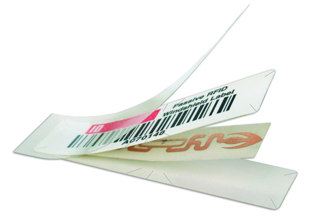
An example of an RFID tag “hidden“ underneath a barcode – Metalcraft
The art and science of using RFID technology is too far-reaching to go into details for the purpose of this article, but it is important to note that we already use RFID in our daily lives—in the keys that open your car door and start the engine, for example, and in the automatic payments you make as you speed through highway toll booths, the access systems in buildings, our passports, payment cards, and even student ID cards. These items are uniquely identified as part of the IoT ecosystem.
Essentially, RFID technology is the conduit between the physical world and the digital world. It allows physical objects to be wirelessly identified and differentiated by computers.
The roadmap to a future where RFID tags replace barcodes on our food packaging is still a long way off. For one thing, the cost of RFID tagging needs to be lower than one cent per tag, and current cost averages are around ten cents per tag. But as you can see in this video
, RFID technology is already in use in the retail fashion industry because it’s a better way to keep track of and manage inventory, especially for higher value products like shoes and suits. 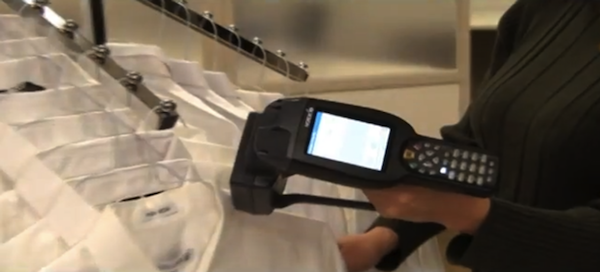
How RFID Benefits Retail Fashion – An RFID Network Video
I asked Brian Hume, the Managing Director of Martec International, a leading retail research firm, when he thinks RFID tags will replace barcodes in our supermarkets and on our food packaging. While he doesn’t see it happening for a long while due to the cost. He does see RFID making progress with more expensive items.
“In Europe, for example, many supermarkets sell clothing (apparel not fashion!) and electricals like kettles, coffee machines, etc. and the margins can stand the cost,” Hume says. “One thing that may change it, though, are Nanocircuits printers. These can print the RF coil inside laminated layers of paper, [which] may get the cost down to something much closer to the cost of printing a bar code.”
Connected Devices
The second category of objects in the Internet of Things is connected devices. These devices have built-in network conductivity and usally require a power source to operate. We can already see these devices all around us today: Smartphones and tablets and sensor-enabled devices like CubeSensors, connected light bulbs, learning thermostats, or even a smart fridge.
These connected devices will become part of a digital grid that could affect every facet of our daily lives. Sensor devices will monitor our health, track our daily activity, and remotely monitor an aging family member. A connected home will reduce our monthly utility bills and tell us when to water our plants. Smart cities will light their streets more efficiently, receive instant reports on hazards, and even help residents find a nearby parking spot.
Industries will optimize their operations and boost productivity by better tracking inventories and other assets while maintaining quality control and consistency in their products and services. The environment will be monitored for a better understanding and management of natural resources, or to send advance warnings of a pending disaster.
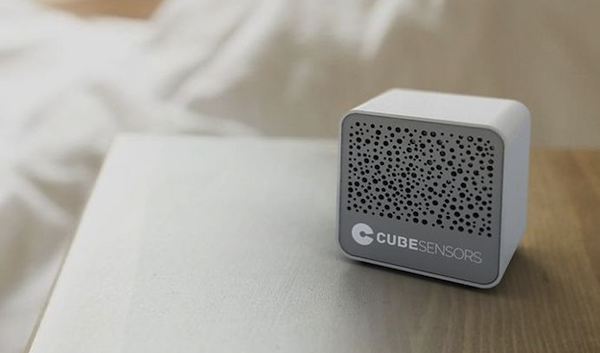
CubeSensors – Improving indoor living
The “Myth” of the Smart Fridge
In many homes the kitchen is considerd the center of the house. This is where we cook food and where our families get together to eat meals. The refrigerator is center of all that, and therefore plays an important role in our daily lives. Since 1998, when the first smart fridge was introduced (see the Evolution of the Fridge Computer), developers, designers, and manufacturers have been imagining fridges that could change our lives.
The future refrigerator will be semi-transparent, and the opaque smart display will display exactly what’s inside, so we only have to open the door once we know what we want. Neatly organized food items will be recognized and categorized via sensors. We will be able to do things like place items on hold (e.g., reserving the carrots for Sunday dinner).
As you see in the image below (from the productivity future vision video by Microsoft), leftovers will have clear expiration dates, the fridge will calculate the freshness of food and automatically create a shopping list when we’re missing or are low on essential items like milk. The smart fridge will even be able to order these items automatically. It will suggest recipes based on ingredients in the fridge and help us maintain our diets.
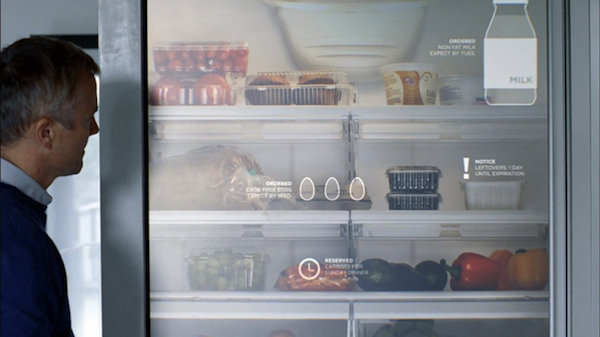
An image from the Productivity Future Vision video (2011) – Microsoft
A perhaps more realistic version of the future says that the smart fridge will manage and keep track of our food by scanning the barcodes of items (or of a shopping receipt) as we place items into the fridge. Or maybe voice-recognition technology will enable the tracking of items by hearing us describe them. All we have to say is “three tomatoes,” “a dozen eggs,” or “cooked tomato pasta” when placing items into the fridge, which will then record the current date and add an expiration date, so we never eat stale or spoiled food.
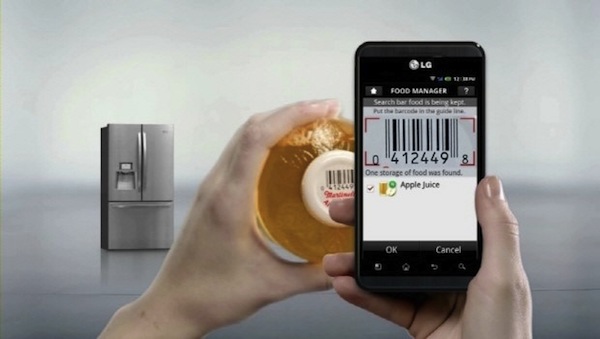
LG Smart Refrigerator – Smart Manager Barcode Scanner
The Samsung T9000 “smart” refrigerator is a good example of a fridge which has software that can track its contents. It has a built-in grocery manager, which allows you to manually add food (with a drag-and-drop interface), and set a reminder and expiration date, so you never lose track of what’s in the fridge.
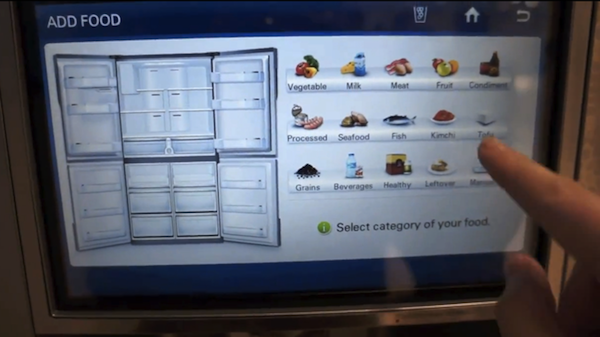
CES 2013 – Samsung T900 Smart Fridge video
The Internet of Things and the Smart Fridge of the future
When I first saw this impressive video by Microsoft, released in 2011, showcasing the futuristic smart fridge, I thought, “It’s just a myth. How could something like this ever become reality?” I was reminded of this 1957 movie which predicted that, by the year 2000, a glassed fridge would keep our food fresh for at least six months.
So what does the fridge of the future look like? Both the 1957 and the 2011 movies had it just about right. The door of the future fridge may be translucent. We won’t need to open the door to see what’s inside. The glass that makes this possible is called smart glass, and it’s already a reality, as you can see in this video.
What about the other part of this mythical fridge’s functionality? Will the smart fridge be able to manage and keep track of its contents, either manually by scanning the items, with voice commands, or by using sensors? Will the smart fridge of the future be able to keep track of what’s inside?
Let’s review some basic assumptions about how we use our fridge.
- We use it to store food and extend the food’s lifespan by keeping it cool.
- In an average household, members open the fridge door about 50 times a day, most often to retrieve food or place food inside.
- Interaction with the fridge is minimal and quick: open the door, close the door.
- Food is randomly placed inside a fridge, usually wherever there is an empty spot. Some food items have a spot where they are almost always placed, like a milk carton in the inside door.
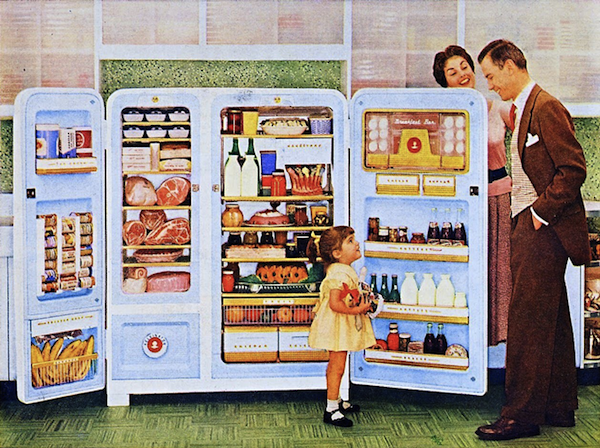
The 1955 Kelvinator Foodarama Refrigerator-Freezer
So the question is, will consumers be willing to use a fridge that requires them to manually scan food or place items neatly in specific spots or in special canisters so that sensors can analyze and keep track of food? Probably not.
Convenience is a strong differentiator, and consumers will tend to adopt technology that is most convenient to their way of life. If smart fridge users have to scan items manually, or interact with a screen while placing food items into the fridge, the smart fridge will become a novelty and the added “smart” functionality will scarcely be used. That would be a shame.
So What’s a Smart Fridge to Do?
The core functionality of the smart fridge, beyond the four assumptions I reviewed earlier, is to maintain, with minimum effort, an inventory list of perishable food items and their expiration dates. And when I say minimum effort, I mean no effort at all. In fact, users of the smart fridge will not have to change any behavior to maintain this inventory list. They would just keep using the fridge, as they’ve been doing in the centuries since the first fridge was invented.
This is where RFID technology and the Internet of Things starts to kick in. RFID technology will eventually replace the barcode, therefore any product that has a barcode today will have an RFID tag in the future. This includes most of the food products we place in our fridge. Every product will have a unique identifier representing the product name and the expiration date. The smart fridge will have an RFID reader embedded in every shelf. This reader will scan for RFID tags every time the refrigerator door is opened and closed.
This technology is already available. Smart Cabinets or RFID Cabinets are used to keep track of high value products in a wide range of markets, including healthcare, medical device, biotechnology, and security. Smart Cabinet users first identify themselves with a personal key card card to open the door. Then they remove any item from the shelf. Of course, all items in the Smart Cabinet have RFID tags attached to them. Information is captured in real-time so managers always know what they have in stock.
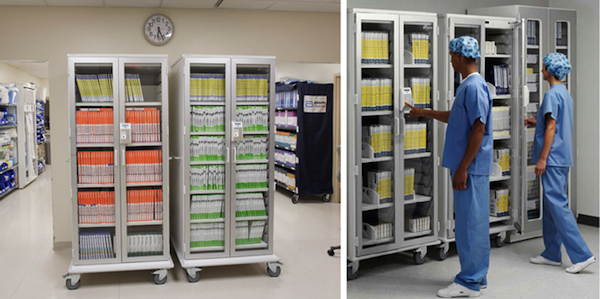
Stanley InnerSpace SpaceTRAX® plus RFID
What about fruits and vegetables or cooked food, you may ask? How can the smart fridge track these? And my answer is, it won’t. We don’t really need to track everything in our fridge. I also don’t think that we should rely so heavily on technology in every facet of our lives. The average person remembers when he or she cooked and placed leftover pasta in the fridge. If needs be, he or she can always manually add this data or create a reminder about the expiration date for him or herself. Using the smart fridge should be effortless, and smart functionality should not try to change behaviors or take over our lives.
Similar to Nest, a thermostat that learns household users and their use patterns, the smart fridge of the future will also learn. This is what will make it smart. It will learn and record our average food consumption. So, for example, if we replace a milk carton every three days, the smart fridge will understand how much milk is left inside the carton, on average, and can send us alerts when we are low. Over time, we will be able to see the patterns of our food consumption, we can determine if we are eating healthy, or we can monitor food waste due to expired products. We will also be able to see how much we spend on our food and thus better manage our household budget.
The fun does not stop here. Mobile applications will be able to tell us in real time what we have in our fridge so we don’t have to create a shopping list before heading out to the supermarket. We will clearly see if we are low on yogurt, or we can run a search for that specialty jam we bought a few months ago but have since forgotten its name.
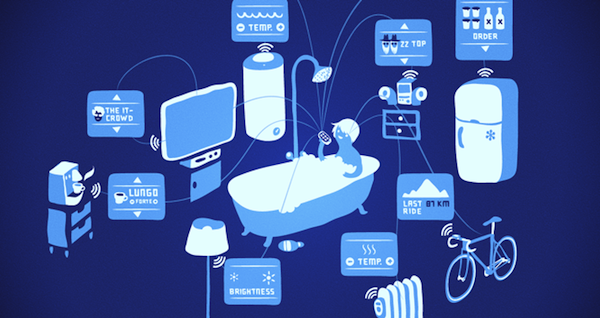
The Web of Things – Image courtesy of Chragokyberneticks
Conclusion
The story of the smart fridge is just a case study, a way to illustrate how identified objects and connected devices will work synergistically to create a new consumer product, in this case a new home appliance. Of course, the Internet of Things is more far-reaching than just the tracking of food in our fridge. Ultimately designers must always consider how this new technological era can benefit humanity, from reducing the ecological impact of mankind on the planet to helping people maintain healthier lifestyles.
We must also be wary and vigilant about users’ privacy and security issues. These factors are key to marketplace acceptance of these new connected products and will greatly affect the Internet of things.
This era will presents almost unlimited great opportunities to pioneer new territories, by innovating new products, and by creating rich interactions with technology. The work is not going to be easy, much of the road ahead is still unpaved, but it’s definitely going to be fun.
To learn more about future smart appliances, I suggest reading Scott Jenson’s “Deconstructing the Internet of Things.”







